Kyrgyzstan is home to a wide variety of birds, with over 300 species recorded in the country. From soaring golden eagles to the diminutive Blue-capped Redstart, Kyrgyzstan’s avifauna is as diverse as its landscapes.
From the soaring alpine meadows to the steppes of the south, Kyrgyzstan is an ideal habitat for a variety of birds. In this article, we will be exploring some of the fascinating Kyrgyzstan birds and their habitats.
1. Sittidae
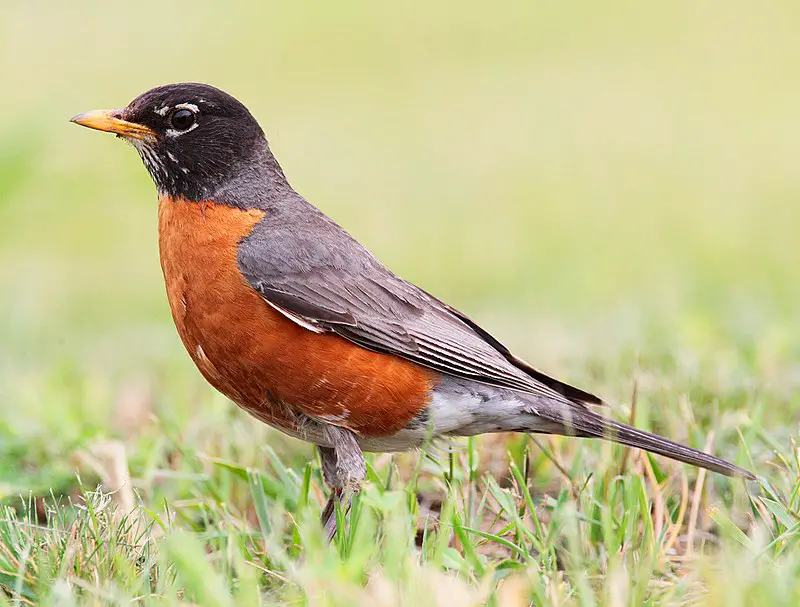
Sittidae, commonly known as nuthatches, are a family of small passerine birds found throughout the world.
They have short tails and powerful beaks that allow them to access nuts and seeds stored in tree bark or inside crevices.
Their sharp claws enable them to climb up vertical surfaces like trees with ease. Nuthatches usually feed on insects, spiders, caterpillars, snails and other invertebrates; they also eat some fruits and berries during winter months when food is scarce.
These birds live in forests across temperate regions where deciduous trees are abundant such as Europe and Asia but can also be seen at higher altitudes in mountains around the world including North America’s Rocky Mountains range.
Nuthatches may form monogamous pairs for life or gather together into flocks while feeding during winter season which helps them survive difficult climatic conditions better than if they were alone
2. Bar-Tailed Treecreeper
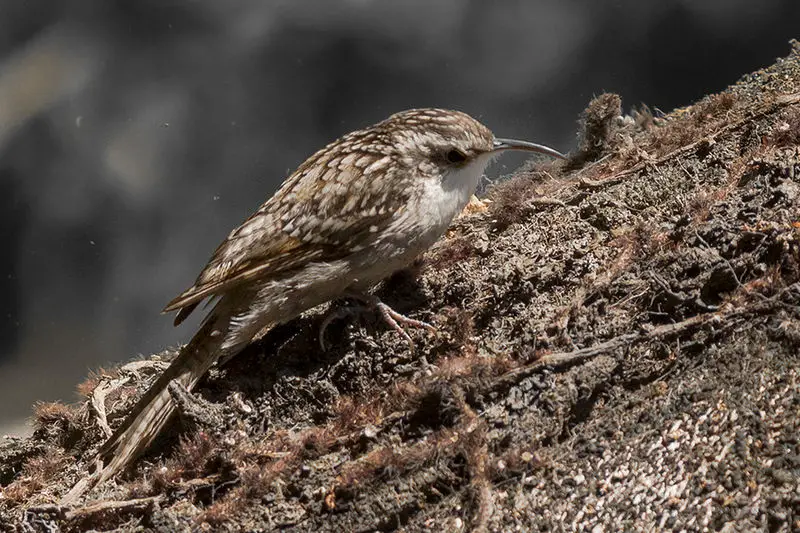
The Bar-tailed Treecreeper is a species of bird found in the northern parts of the Indian subcontinent, including Afghanistan, India, Iran and Nepal.
It has adapted to live mainly in coniferous forests and rocky hillsides at an altitude range from 1000m – 4500m.
Its plumage is generally greyish brown above with white underparts and rufous wings; it also bears a small bill which helps them seek out insects hidden deep within tree bark or cracks.
They are agile climbers who creep up trunks searching for food such as ants and other tiny invertebrates using their long curved claws.
The Himalayan Treecreeper can often be seen clambering around trees during its active hours between dawn till dusk making loud calls that sound like “chick chick”.Scientific classification:
| Kingdom | Animalia |
| Phylum | Chordata |
| Class | Aves |
| Order | Passeriformes |
| Family | Certhiidae |
| Genus | Certhia |
| Species | C. himalayana |
3. Sylviid Warblers
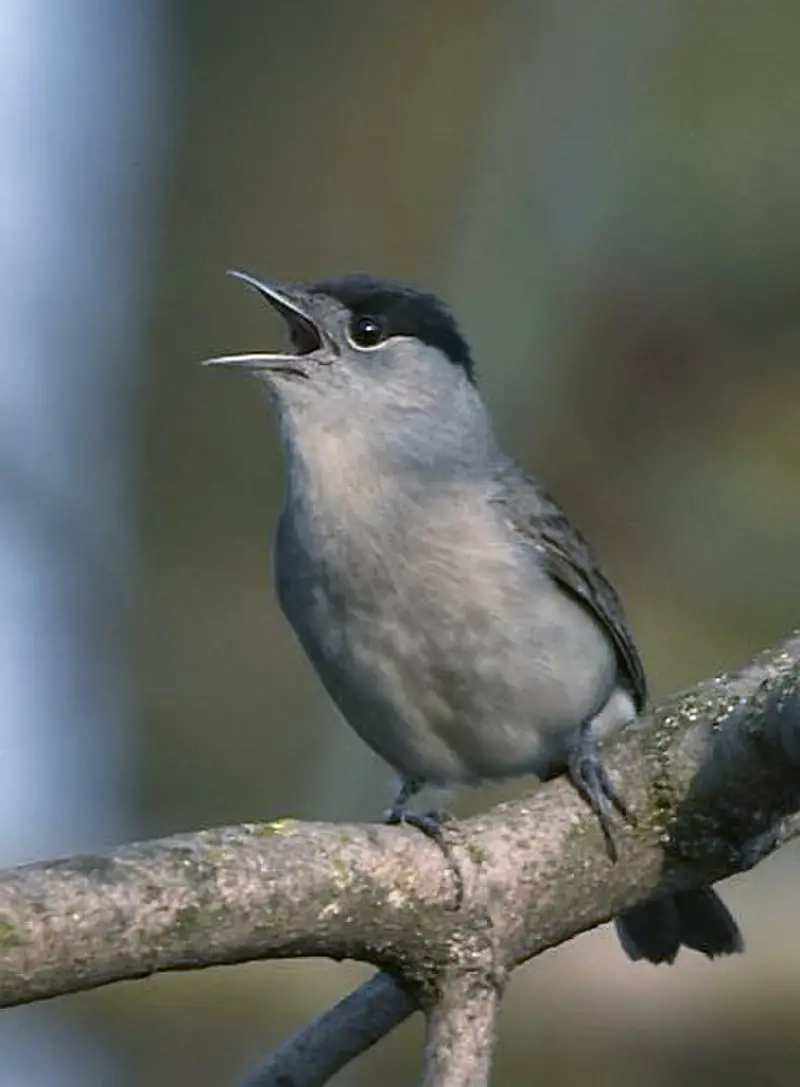
The Sylviid warblers are a family of passerine birds found in Eurasia and Africa. They include the typical warblers as well as babblers that were formerly part of the Old World babbler family.
These birds have slender bodies, pointed wings, long tails and strong legs adapted for ground-dwelling habits like running or hopping along branches.
The male often has bright colors while females are usually duller in coloration with more muted plumage patterns than males.
Some species also show sexual dimorphism where one sex may be larger or smaller than its counterpart; for instance some species may have longer tail feathers on the female side compared to their male counterparts.
Many members of this group feed on insects but some specialize on seeds, fruits, nectar or even frogs.Scientific classification:
| Kingdom | Animalia |
| Phylum | Chordata |
| Class | Aves |
| Order | Passeriformes |
| Superfamily | Sylvioidea |
| Family | Sylviidae Leach, 1820 |
4. Waxwing Birds

Sittidae, commonly known as nuthatches, are a family of small passerine birds found throughout the world.
They have short tails and powerful beaks that allow them to access nuts and seeds stored in tree bark or inside crevices.
Their sharp claws enable them to climb up vertical surfaces like trees with ease. Nuthatches usually feed on insects, spiders, caterpillars, snails and other invertebrates; they also eat some fruits and berries during winter months when food is scarce.
These birds live in forests across temperate regions where deciduous trees are abundant such as Europe and Asia but can also be seen at higher altitudes in mountains around the world including North America’s Rocky Mountains range.
Nuthatches may form monogamous pairs for life or gather together into flocks while feeding during winter season which helps them survive difficult climatic conditions better than if they were alone
5. Black-Throated Loon
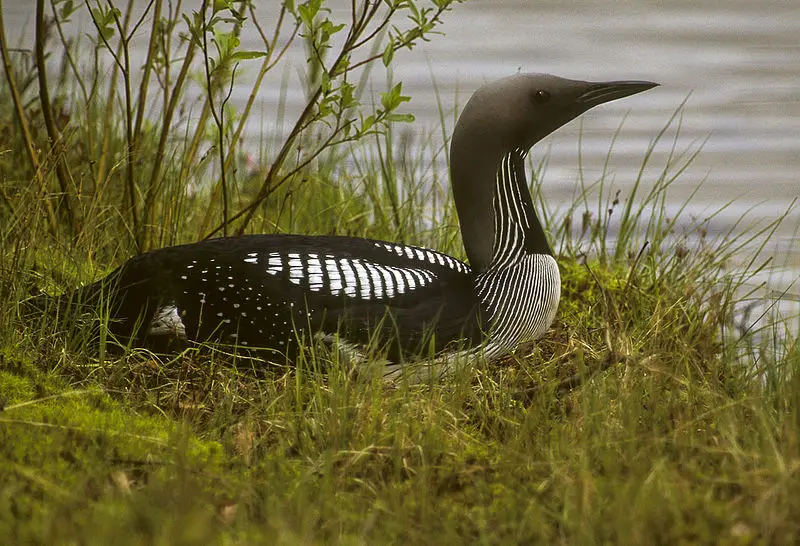
The black-throated loon is an impressive migratory bird, found in the northern hemisphere. During breeding season, these loons prefer freshwater lakes of Europe and Asia as their home.
In winter, they migrate to sheltered coastlines on both sides of the Atlantic Ocean and Pacific Ocean which remain free from ice during that time.
First described by renowned botanist Carl Linnaeus in 1758, this species has a unique appearance with its slender body covered mostly in grey feathers paired with white patches around its neck region along with a contrasting black throat patch giving it its name – The Black-Throated Loon.
These birds are also known for their elegant swimming style while hunting small fish underwater making them one of nature’s most fascinating creatures.Scientific classification:
| Kingdom | Animalia |
| Phylum | Chordata |
| Class | Aves |
| Order | Gaviiformes |
| Family | Gaviidae |
| Genus | Gavia |
| Species | G. arctica |
6. Long-Tailed Tits
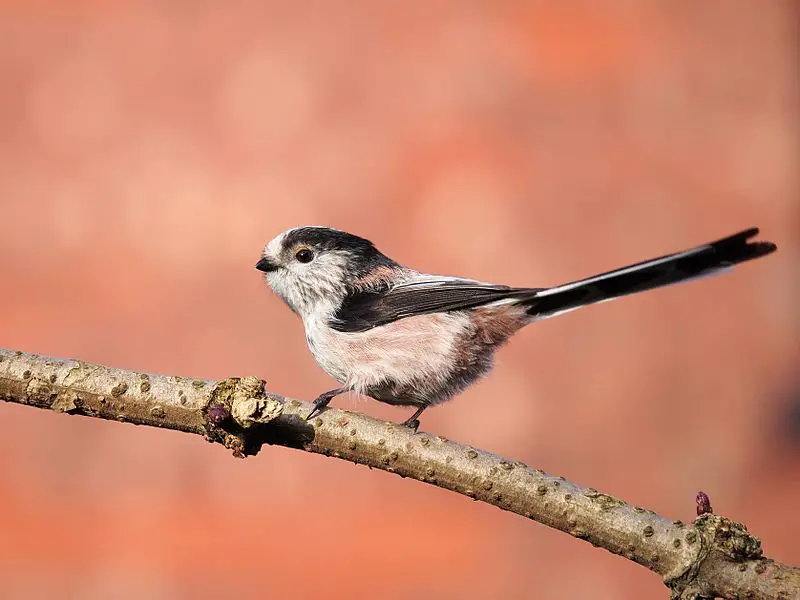
Long-tailed tits are a small passerine bird family with long tails compared to their size. They have 13 species in 3 genera, and they mostly live in Eurasia.
These birds love to stay active by foraging for insects among shrubs and trees throughout the day.
During non-breeding season, these birds can be found living together in large flocks of up to 50 individuals.
These playful little creatures make wonderful companions due to their social nature and cheerful personalities.
Their bright plumage also adds a beautiful splash of colour wherever they go.Scientific classification:
| Kingdom | Animalia |
| Phylum | Chordata |
| Class | Aves |
| Order | Passeriformes |
| Superfamily | Sylvioidea |
| Family | Aegithalidae Reichenbach, 1850 |
7. Streaked Scrub Warbler
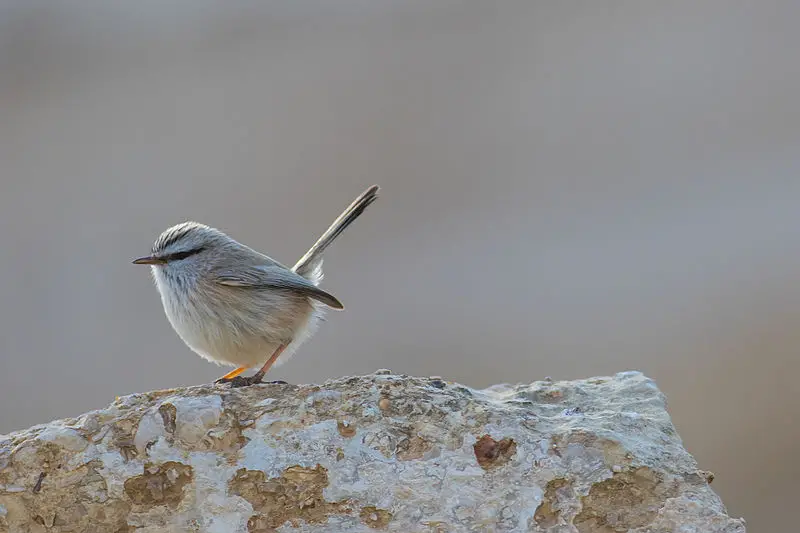
The Streaked Scrub Warbler is a small passerine bird, found in northern Africa and southwestern Asia.
It frequents scrubby areas, ravines and gorges near deserts, remaining mainly resident but with possible local movements outside the breeding season.
This species has grayish-brown upperparts streaked with black lines or bars forming an intricate pattern across its back; whitish underparts are also marked by dark streaks on the breast.
Its diet consists of insects which it catches from low vegetation while making short flights over them to capture prey as well as gleaned items from branches or foliage surface foraged on foot.
The Streak Scrub Warbler is quite vocal throughout the year giving various trills and whistles that sound like “seet”.Scientific classification:
| Kingdom | Animalia |
| Phylum | Chordata |
| Class | Aves |
| Order | Passeriformes |
| Family | Scotocercidae Fregin, Haase, Olsson, & Alström, 2012 |
| Genus | Scotocerca Sundevall, 1872 |
| Species | S. inquieta |
8. Saxaul Sparrow
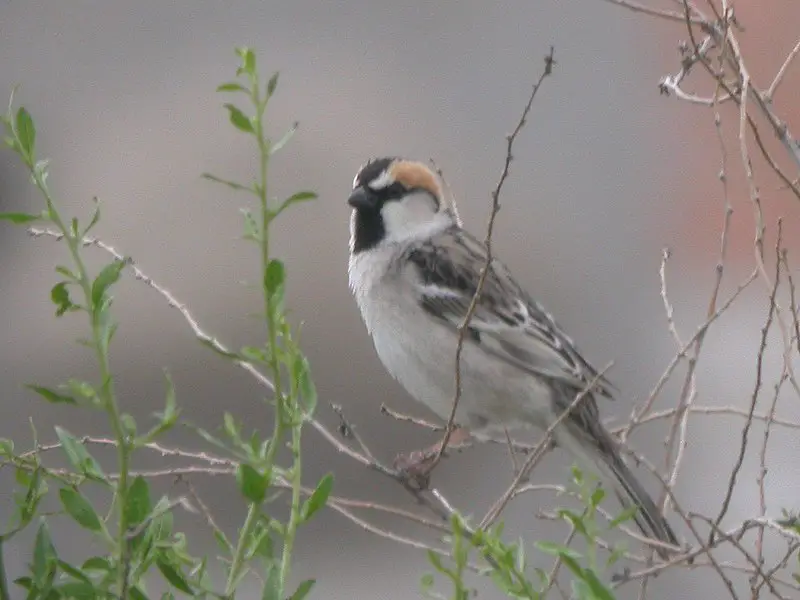
The Saxaul Sparrow is a passerine bird of the sparrow family Passeridae, native to Central Asia. They are relatively large compared to other types of sparrows, measuring between 14-16 centimeters and weighing around 25-32 grams.
Their plumage varies from dull grey to sandy brown with pale legs. Females possess less vibrant plumage than males and lack the black stripes on their bills that characterize male birds.
Saxaul Sparrows inhabit open areas such as steppes or deserts where they forage for food including seeds, small insects, fruits and buds among others items found in these habitats..
Due to its wide range across central Asian countries it has been designated by IUCN as Least Concern status since 2004 .Scientific classification:
| Kingdom | Animalia |
| Phylum | Chordata |
| Class | Aves |
| Order | Passeriformes |
| Family | Passeridae |
| Genus | Passer |
| Species | P. ammodendri |
Also Featured In: Common Uzbekistan Birds,
9. White-Crowned Penduline Tit
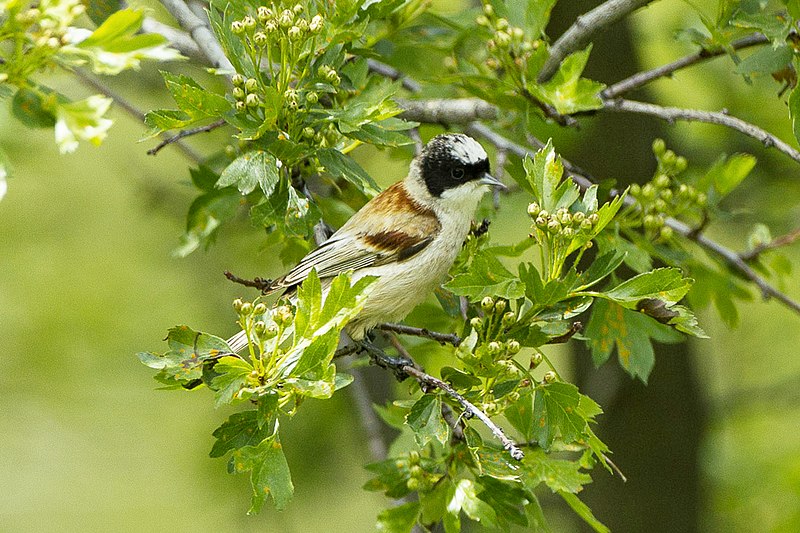
The white-crowned penduline tit is a species of bird found in various parts of Asia such as Afghanistan, China, India, Kazakhstan and Tajikistan. This small bird typically lives in boreal forests or temperate woodlands.
They have distinctive black upperparts which contrast with the bright yellow underparts and white crowns on their heads.
These birds mainly feed off insects but also consume berries from time to time. White-crowned penduline tits are very active during daylight hours when they can be seen gathering food around trees or shrubs near water sources like streams or ponds.
During winter months these birds may form flocks with other tit species for protection against predators while searching for food together across large areas of land.
Overall these beautiful little birds make wonderful additions to any backyard aviary.Scientific classification:
| Kingdom | Animalia |
| Phylum | Chordata |
| Class | Aves |
| Order | Passeriformes |
| Family | Remizidae |
| Genus | Remiz |
| Species | R. coronatus |
10. Stone-Curlew

Stone-curlews, also known as dikkops or thick-knees, are a family of birds that have adapted to live in tropical and temperate regions throughout the world.
They can be found in Africa, Asia and Australia with two or more species per region. Despite being classified as waders, most prefer dry arid habitats over moist wetlands.
Stone-curlews typically have long legs which help them navigate through their preferred terrain efficiently; some species even stand at an impressive height when standing on those long legs.
Additionally they feature cryptic plumage which helps them blend into their surroundings while hunting for prey such as insects and small mammals like rodents.
These unique bird’s calls are easily recognizable; it has been said that hearing one is similar to listening to someone whistling ‘Keee Weee’.Scientific classification:
| Kingdom | Animalia |
| Phylum | Chordata |
| Class | Aves |
| Order | Charadriiformes |
| Suborder | Chionidi |
| Family | Burhinidae Mathews, 1912 |
11. Stilts And Avocets
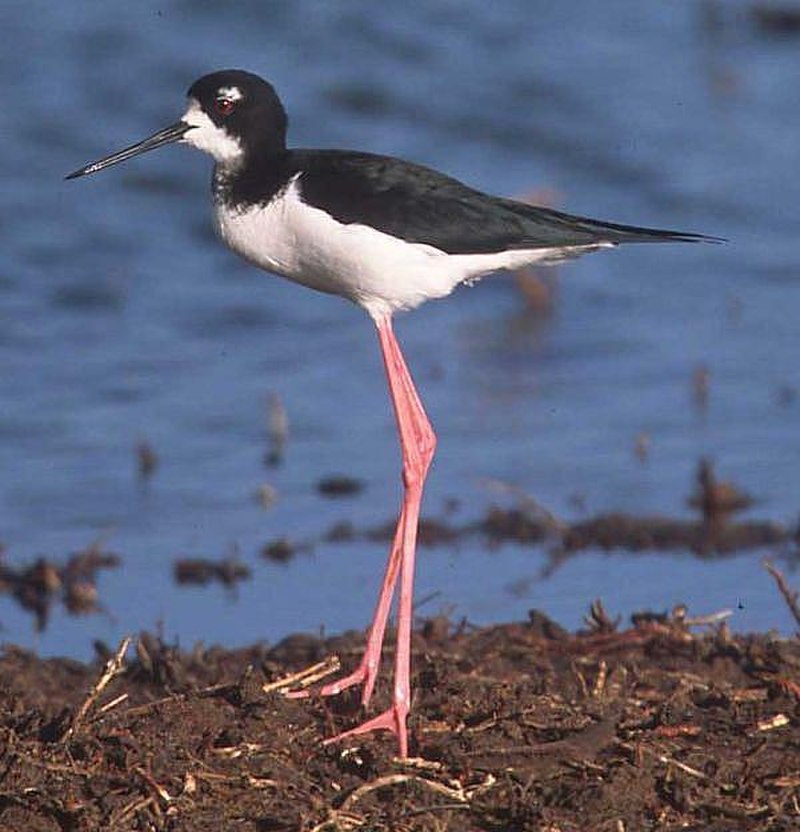
Stilts and avocets are two distinct groups of birds belonging to the family Recurvirostridae. They range in length from 30-46 cm (12-18 inches) and weigh between 140 – 435 g (4.9 – 15.3 ounces).
Males usually have slightly larger bodies than females, with long thin legs, necks and bills.
Avocet bills curve upwards uniquely while stilt beaks remain straight most times.
These wading birds live mainly near shorelines or wetlands where they feed on aquatic invertebrates like brine shrimp, insects etc., occasionally supplementing their diet with seeds or small fish too.
Stilts also inhabit open fields in search of food sources such as earthworms or grasshoppers during the non-breeding season.
Both groups migrate over large distances for warmer weathers when it gets cold outside.Scientific classification:
| Kingdom | Animalia |
| Phylum | Chordata |
| Class | Aves |
| Order | Charadriiformes |
| Suborder | Charadrii |
| Family | Recurvirostridae Bonaparte, 1854 |
12. Glareolidae
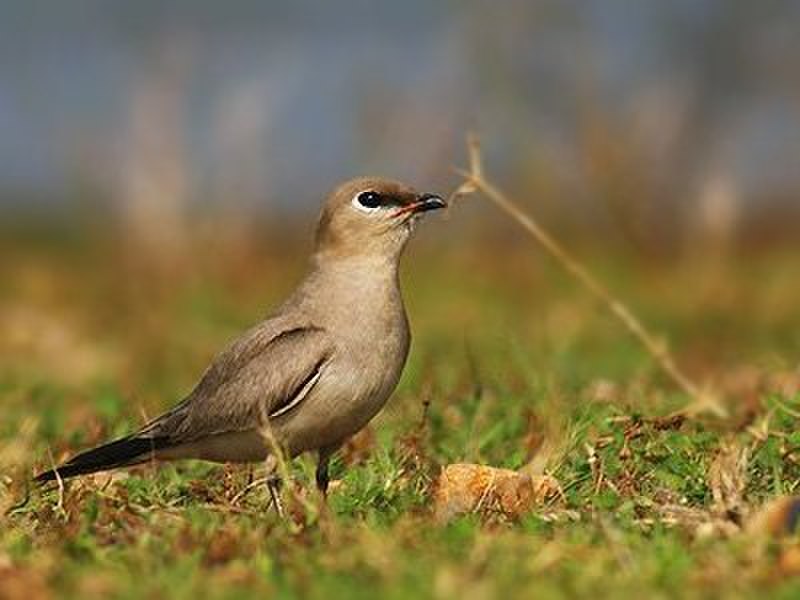
Glareolidae is a family of wading birds, consisting of four genera and 17 species. They are distinguished from other charadrii by their long bills which have a slight downward curve.
Glareolidae live around open grasslands and deserts, where they hunt for insects using the bill to probe into soil or vegetation.
Most species are found in Africa but two pratincoles inhabit parts of Europe and Asia as well.
Coursers tend to be larger than pratincoles with longer legs allowing them to run quickly across sandy dunes while feeding on small animals like lizards or spiders.
Pratincoles feed mainly on flying insects, snatching them out of midair with great agility during flight.
All glareolids share unique features such as large eyes that help it spot prey at night easily making this group one interesting bird family.Scientific classification:
| Kingdom | Animalia |
| Phylum | Chordata |
| Class | Aves |
| Order | Charadriiformes |
| Suborder | Lari |
| Family | Glareolidae CL Brehm, 1831 |
13. Black-Throated Accentor
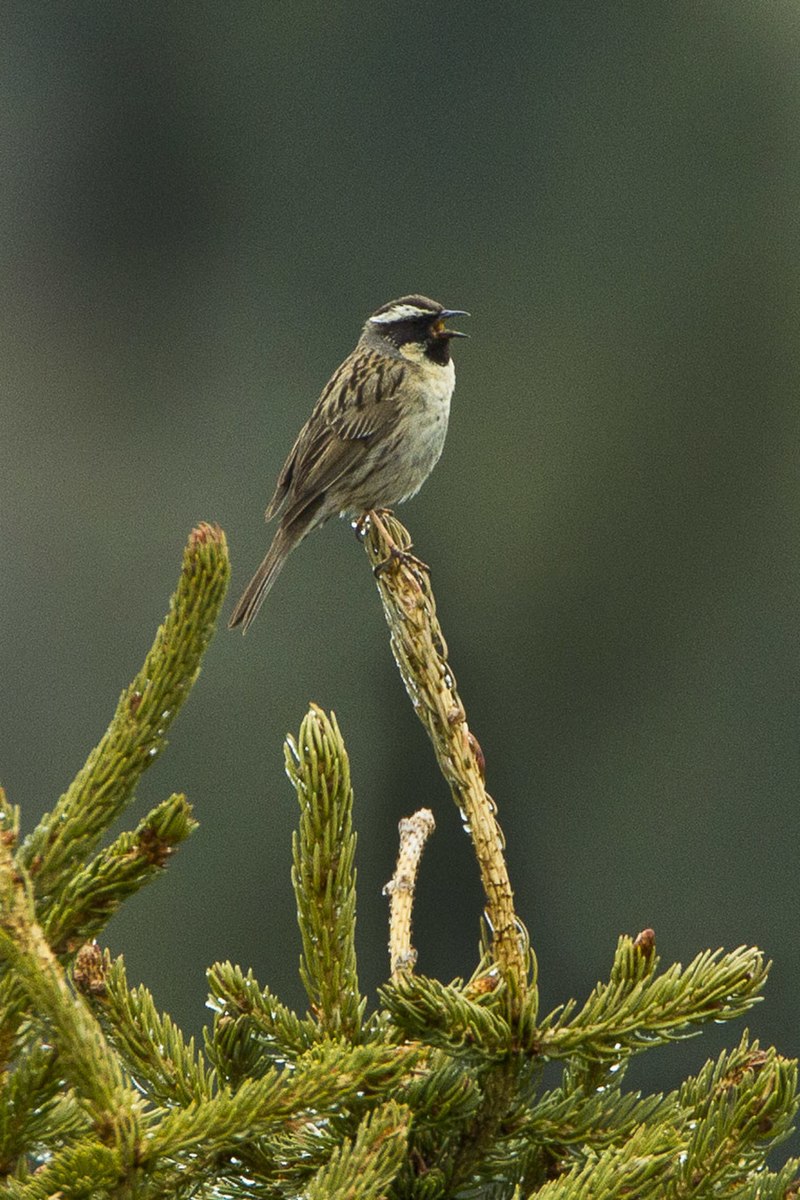
The black-throated accentor is a small passerine bird found in the Ural, Tian Shan and Altai Mountains. During winter it migrates to Afghanistan and neighboring countries as well as being an occasional vagrant in western Europe.
This dunnock-sized bird builds its nest low down amongst spruce thickets where it lays 3-5 unspotted blue eggs.
It can be seen during winter foraging through scrub or cultivated areas looking for food such as insects, spiders and berries which make up its diet.
This species is quite shy but if you are lucky enough to spot one they characteristically flick their wings while singing from perches at mid level height of trees or bushes making them easier to identify than other birds of similar size.Scientific classification:
| Kingdom | Animalia |
| Phylum | Chordata |
| Class | Aves |
| Order | Passeriformes |
| Family | Prunellidae |
| Genus | Prunella |
| Species | P. atrogularis |
14. Saker Falcon
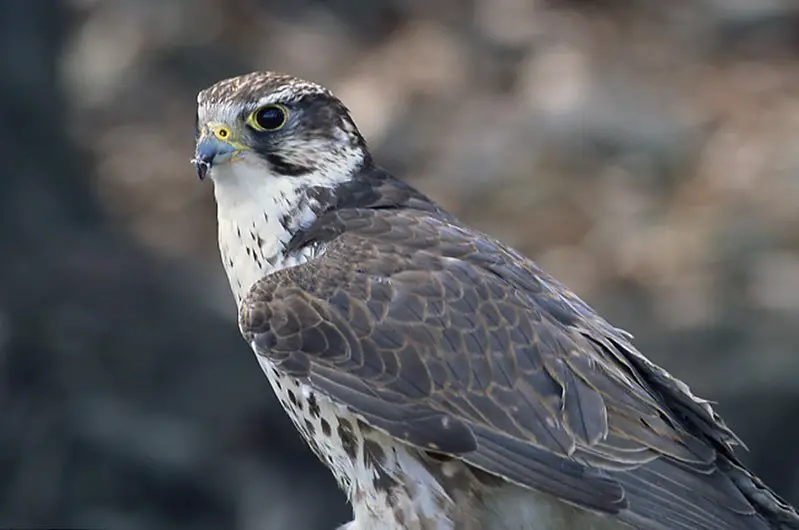
The saker falcon is a large species of falcon that is found across the Palearctic from central Europe all the way to Manchuria.
It typically migrates, except for in southern parts of its range where it winters in Ethiopia, Arabia, northern Pakistan and China.
This majestic bird has been designated as the national bird of Hungary, United Arab Emirates and Mongolia due to its beauty and gracefulness.
Its plumage can be brownish-grey or light grey with dark spots while they have bright yellow eyes which contrast their feathers beautifully.
They are also quite agile when flying at high speeds with wingspan ranging between 1-1.5 m long – perfect for soaring.Scientific classification:
| Kingdom | Animalia |
| Phylum | Chordata |
| Class | Aves |
| Order | Falconiformes |
| Family | Falconidae |
| Genus | Falco |
| Subgenus | Hierofalco |
| Species | F. cherrug |
15. Black-Necked Grebe

The Black-necked Grebe is a beautiful water bird belonging to the grebe family. It has an ochre coloured plumage with distinctive features which include extending behind its eyes and over its ear coverts.
The upper parts of this species are black, while their underparts and neck are white in colour.
During breeding season, males develop a dark grey crown on top of their head along with bright yellow facial stripes that run from the beak down to it’s chest area.
These birds feed mainly by diving underwater for insects, crustaceans, larvae, molluscs as well as small fish that they find in shallow waters or wetlands near freshwater lakes or streams.
They can often be spotted swimming alone but during winter months gather together creating large flocks due to mating activity taking place at these times.Scientific classification:
| Kingdom | Animalia |
| Phylum | Chordata |
| Class | Aves |
| Order | Podicipediformes |
| Family | Podicipedidae |
| Genus | Podiceps |
| Species | P. nigricollis |
16. Lesser Sand Plover
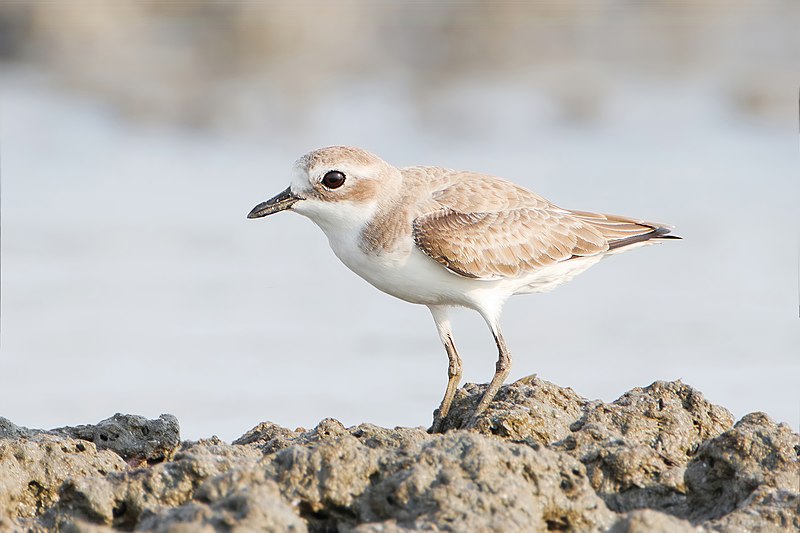
The Lesser Sand Plover is a small wader bird belonging to the plover family. It has yellowish-brown upperparts and white underparts, with a distinct black band across its chest and whitish forehead.
Its wings are short but powerful, allowing it to cover large distances in search of food such as insects, worms or crustaceans found on muddy beaches or shallow lagoons near coasts.
The species prefers habitats with low vegetation like sandy deserts, coastal dunes and salt flats where they can hide among the sand grains while foraging for food during their migrations between Africa and Asia.
These birds form monogamous pairs that breed annually in springtime; nests consist of scrapes made on the ground lined with pebbles or shells carefully arranged by both parents who will vigorously defend them against predators until chicks fledge after about four weeks from hatching.Scientific classification:
| Kingdom | Animalia |
| Phylum | Chordata |
| Class | Aves |
| Order | Charadriiformes |
| Family | Charadriidae |
| Genus | Charadrius |
| Species | C. mongolus |
Also Featured In: Common Republic of Nauru Birds, Asian Birds
17. Snow Pigeon
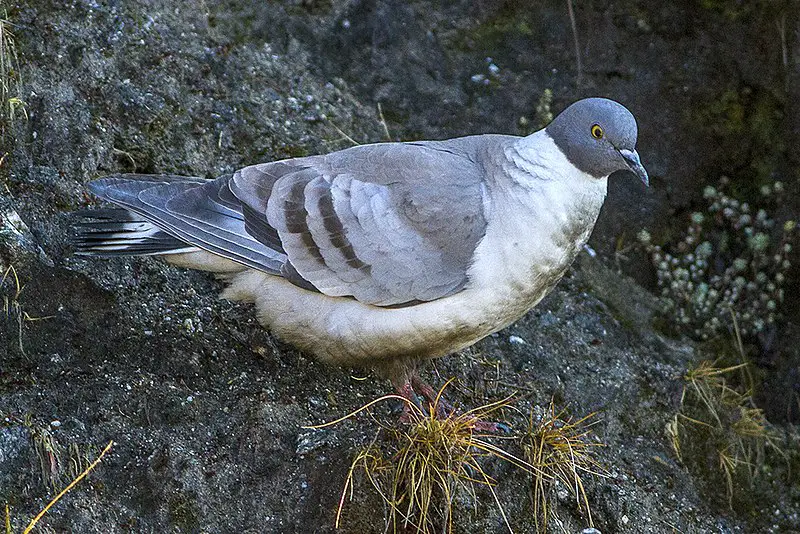
The snow pigeon is a species of bird found in hilly regions of Central Asia. It has various colors such as grey, black, pale brown and white with two subspecies recognised.
The western Himalayas from Western Afghanistan to Sikkim are the home for C. l. leuconota while C. l gradaria lives in eastern Tibet and Eastern Nan Shan (Qinghai).
These birds inhabit open grasslands or scrub forests where they feed on grains and seeds by walking along the ground like most other pigeons do.
They also take insects when available through out their range during summer months due to its catholic diet habits it can survive hostile conditions easily which makes them quite hardy species.Scientific classification:
| Kingdom | Animalia |
| Phylum | Chordata |
| Class | Aves |
| Order | Columbiformes |
| Family | Columbidae |
| Genus | Columba |
| Species | C. leuconota |
Also Featured In: Birds of Ladakh,
18. Pallas’s Leaf Warbler
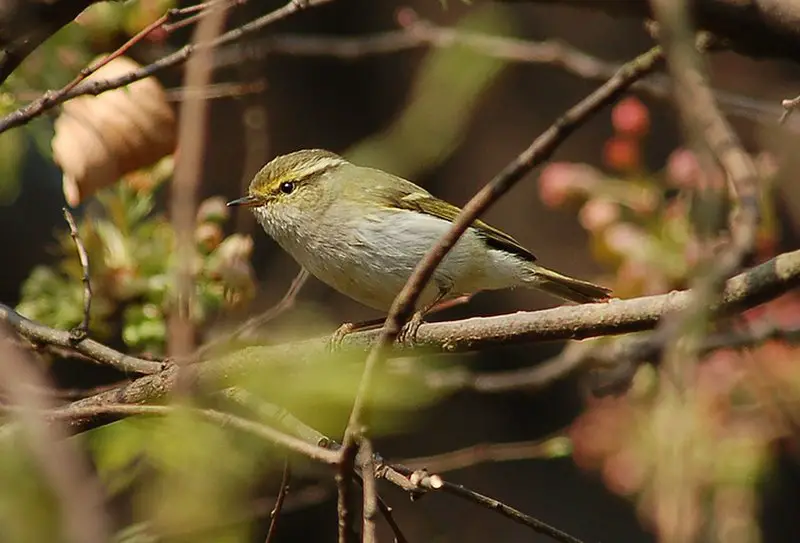
Pallas’s leaf warbler is a species of bird that inhabits mountain forests from southern Siberia to northern Mongolia and northeast China.
It was named after German zoologist Peter Simon Pallas, who first described it in the 1700s.
These birds are strongly migratory, wintering mainly in south China and southeast Asia during cold months.
Their diet consists mostly of insects such as spiders, moths, beetles and caterpillars which they capture by making short flights from perches or shrubs near ground level.
They also eat small berries when available seasonally.
It has an olive-green upper body with yellowish underparts while its head is greyish brown with some rufous patches on the crown region; their wings are long and broad with two white wingbars at each side giving them a distinctive appearance among other warblers in this genus Phylloscopus .Scientific classification:
| Kingdom | Animalia |
| Phylum | Chordata |
| Class | Aves |
| Order | Passeriformes |
| Family | Phylloscopidae |
| Genus | Phylloscopus |
| Species | P. proregulus |
19. Slender-Billed Gull
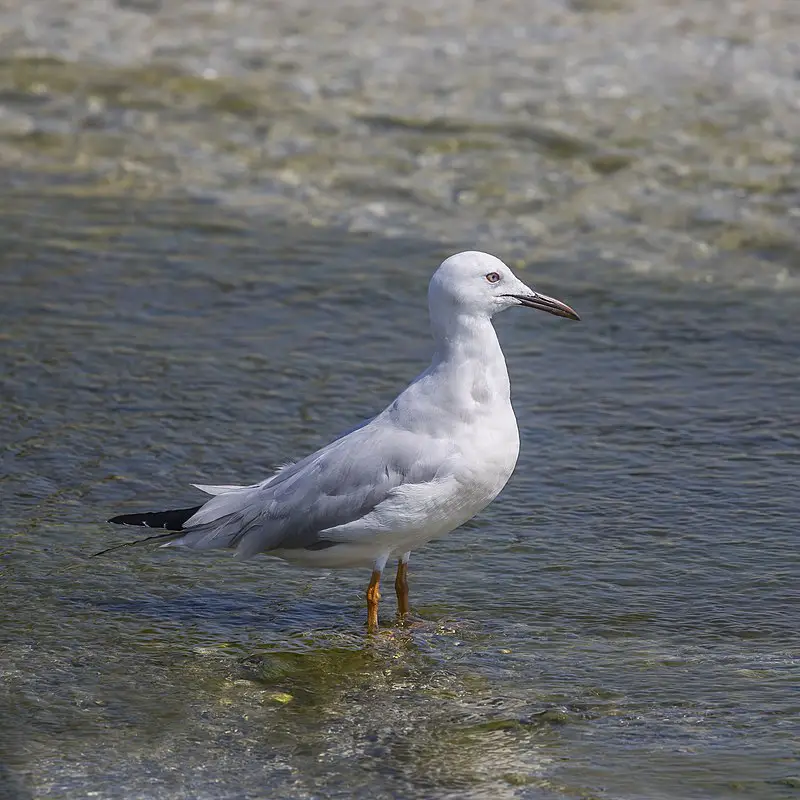
The Slender-billed Gull is a medium sized, migratory bird. It breeds in coastal lagoons and islands around the Mediterranean Sea and North Indian Ocean regions such as Pakistan.
During winter it travels further south to areas like Africa and India, but some individuals have been known to wander off towards western Europe too.
Its long slender bill gives this species its name; an unmistakable feature for identifying these birds among other gulls.
They are generally greyish-brown or white with black wingtips when seen from afar; although up close you can also make out their yellow legs and beak which contrasts nicely against its colouration.
Despite being classified as Least Concern by IUCN they still suffer threats of habitat destruction due to development projects that target their nesting sites along coastlines.Scientific classification:
| Kingdom | Animalia |
| Phylum | Chordata |
| Class | Aves |
| Order | Charadriiformes |
| Family | Laridae |
| Genus | Chroicocephalus |
| Species | C. genei |
20. Red Phalarope
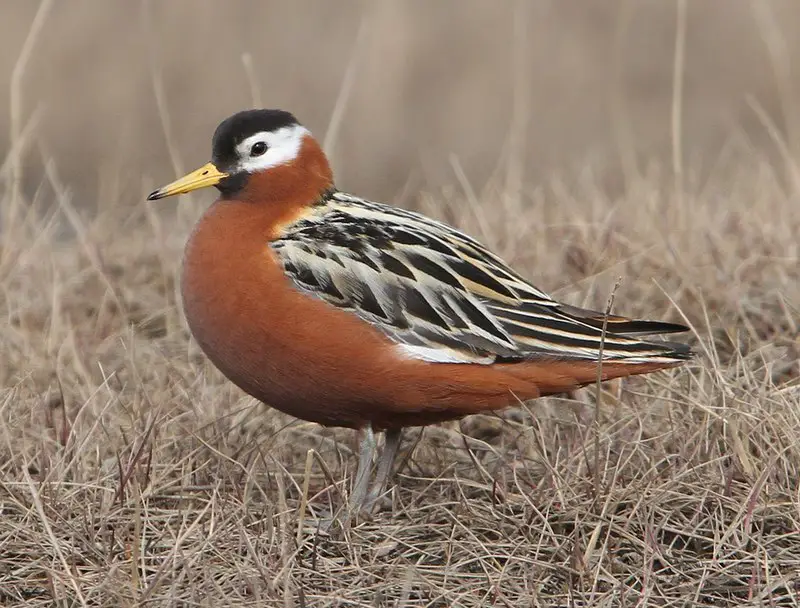
The Red Phalarope (Phalaropus fulicarius) is a small wader, native to the Arctic regions of North America and Eurasia.
During breeding season it will migrate across oceanic routes and winter at sea on tropical oceans – an unusual behaviour for a wader species.
First described in 1750 by George Edwards, this bird has distinctive red plumage with black markings around its neck and wings.
Its bill is thin but sharp which helps them catch their prey from the water’s surface such as insects or fish eggs.
As they are highly agile birds, they can be found spinning rapidly in shallow waters whilst searching for food using their long toes as paddles.Scientific classification:
| Kingdom | Animalia |
| Phylum | Chordata |
| Class | Aves |
| Order | Charadriiformes |
| Family | Scolopacidae |
| Genus | Phalaropus |
| Species | P. fulicarius |
Also Featured In: Birds that Live in Greenland, Birds that Live in Svalbard
21. Red-Breasted Flycatcher
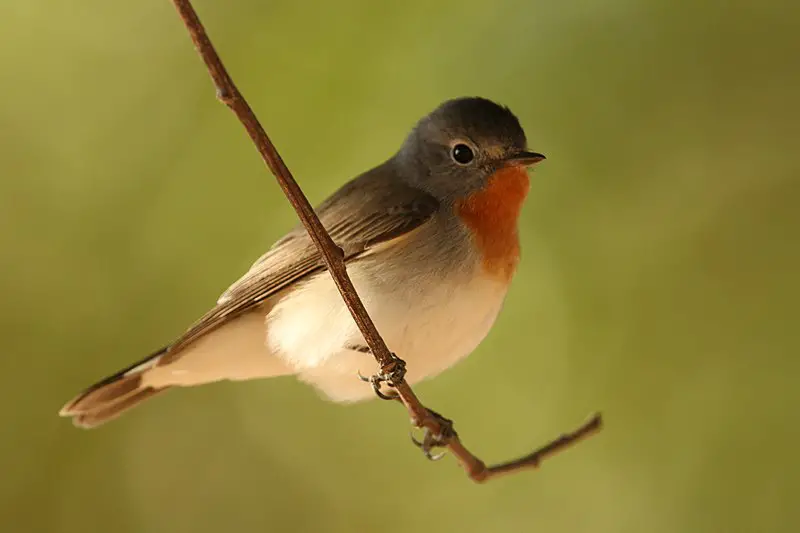
The Red-breasted Flycatcher is a small passerine bird belonging to the Old World flycatcher family. It has a red breast and grey upperparts, with white underparts.
During summertime it can be found breeding in eastern Europe and across Central Asia before migrating southwards to spend winter in South Asia.
In western Europe, it is quite common as a passage migrant due its different migration direction compared to the collared flycatcher which breeds further east.
Its diet consists mainly of insects such as flies, beetles and grasshoppers that are caught on short sallies from perches or trees near water bodies like rivers or ponds where they breed too.Scientific classification:
| Kingdom | Animalia |
| Phylum | Chordata |
| Class | Aves |
| Order | Passeriformes |
| Family | Muscicapidae |
| Genus | Ficedula |
| Species | F. parva |
Also Featured In: Common Slovakian Birds, Birds of Taiga
22. Cotton Pygmy Goose
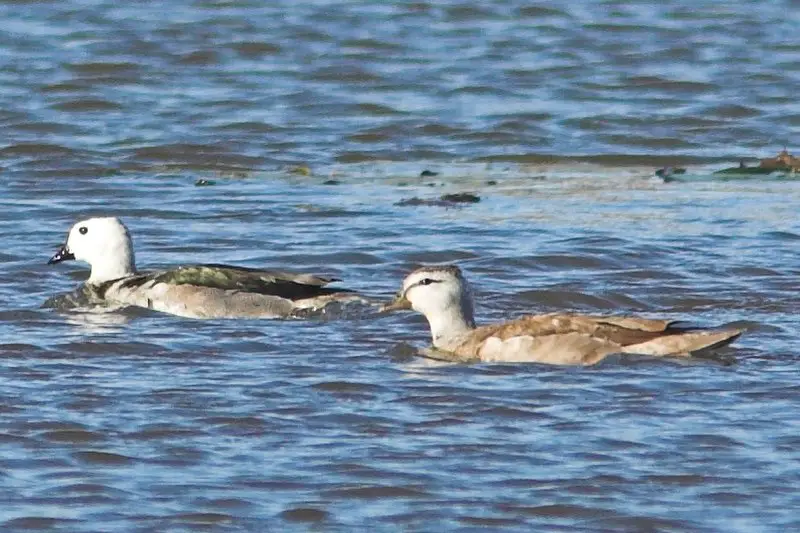
The Cotton Pygmy Goose is a small perching duck found throughout Asia and Southeast Asia, extending south to Queensland.
It stands out among waterfowl as one of the smallest in the world, with a quill-white coloration that helps it blend into its environment.
They often live alone or in pairs but form larger groups when looking for food near bodies of water with plenty of aquatic vegetation.
These birds are omnivorous, feeding on plants like grasses and seeds alongside insects such as beetles and termites.
Their diet also includes fish eggs and larvae from time to time. The cotton pygmies’ size makes them an easy target for predators so they use their agility to quickly escape danger whenever possible.Scientific classification:
| Kingdom | Animalia |
| Phylum | Chordata |
| Class | Aves |
| Order | Anseriformes |
| Family | Anatidae |
| Genus | Nettapus |
| Species | N. coromandelianus |
23. Red-Fronted Rosefinch
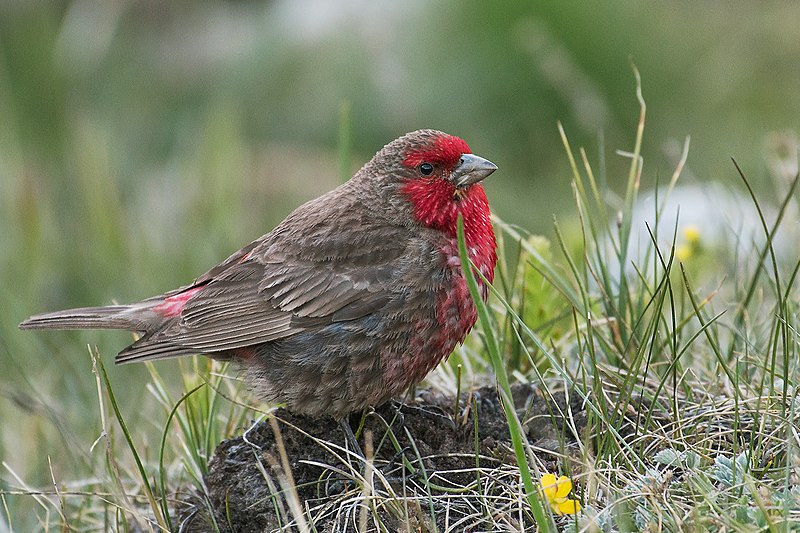
The Red-fronted Rosefinch is a species of rosefinch in the finch family Fringillidae. It has an impressive range, spanning across Afghanistan, Bhutan, China, India, Kazakhstan Nepal Pakistan Russia Tajikistan and Turkmenistan.
These birds can be found inhabiting montane tundra areas. Their feathers are mainly red with grey wings and tail plumage – males usually have brighter colors than females.
They feed on seeds as well as insects such as beetles or flies caught from foliage or ground surfaces during foraging flights.
These birds nest near rocks where they build cup shaped nests among shrubs at low altitudes but will also sometimes settle higher up into trees when conditions permit it.Scientific classification:
| Kingdom | Animalia |
| Phylum | Chordata |
| Class | Aves |
| Order | Passeriformes |
| Family | Fringillidae |
| Subfamily | Carduelinae |
| Genus | Carpodacus |
| Species | C. puniceus |
24. Pied Bush Chat
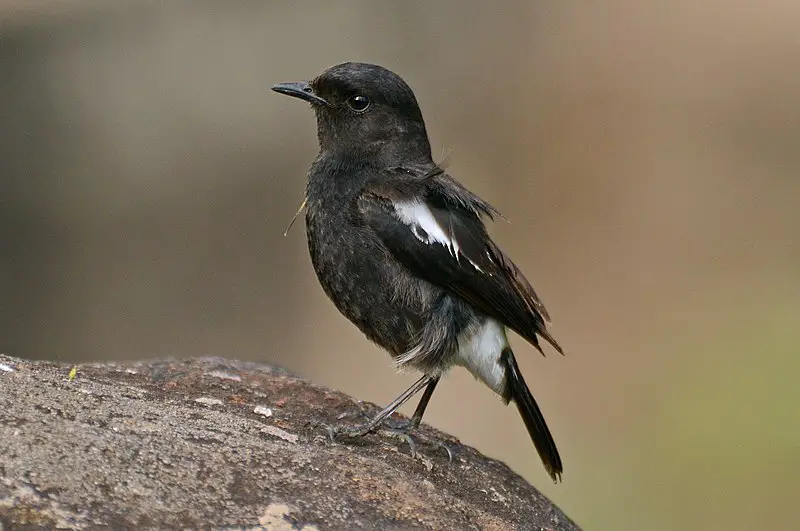
The Pied Bush Chat is a small passerine bird that can be found all over West Asia, Central Asia, the Indian subcontinent and Southeast Asia. It has sixteen different recognized subspecies with many island forms.
This lively little bird loves to hang out in open countryside or scrub land and grasslands, often perched at the top of short thorny trees or shrubs looking for food.
Its diet consists mainly of insects such as beetles, moths and caterpillars; but it also eats some seeds from grains and berries.
The male’s plumage is black above with white below while females are brownish-gray on top with buff underparts streaked dark gray along the sides. Both sexes have a red eye ring which makes them easy to identify.Scientific classification:
| Kingdom | Animalia |
| Phylum | Chordata |
| Class | Aves |
| Order | Passeriformes |
| Family | Muscicapidae |
| Genus | Saxicola |
| Species | S. caprata |
Also Featured In: Common Birds in Bangalore,
25. Long-Legged Buzzard
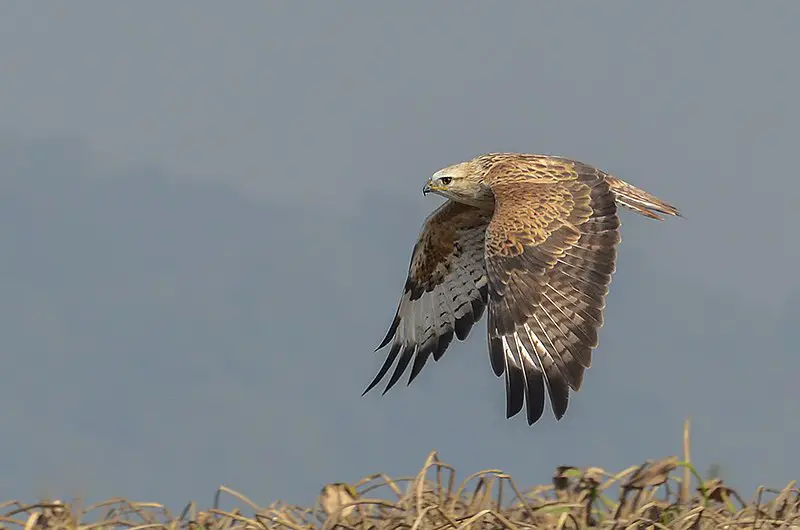
The Long-legged Buzzard is a large bird of prey found in many parts of Eurasia and North Africa.
It has long legs, which allows it to wade through shallow water or even snow when hunting for food.
The diet mainly consists of small mammals such as voles, but also includes amphibians, reptiles and insects.
They are powerful birds that can fly up high into the sky with ease due to their wide wingspan.
This species is often seen soaring on thermals or hovering over open areas looking out for potential meals below them.
With its spectacular eyesight they can spot prey from great distances away before swooping down quickly at incredible speeds to capture their meal.Scientific classification:
| Kingdom | Animalia |
| Phylum | Chordata |
| Class | Aves |
| Order | Accipitriformes |
| Family | Accipitridae |
| Genus | Buteo |
| Species | B. rufinus |
26. Black-Bellied Sandgrouse
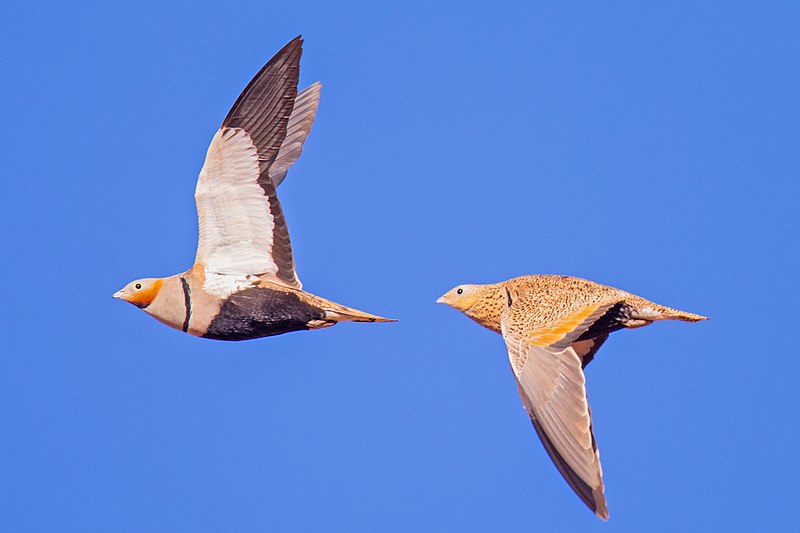
The Black-bellied sandgrouse is a species of medium large bird in the family Pteroclididae. It breeds across Iberia, northwest Africa, Turkey, Iran and Israel as well as on the Canary Islands and Cyprus.
The eastern form of this species can be found in Kazakhstan, western China and northern Pakistan where it migrates seasonally from central Asia.
This ground dwelling bird has greyish – brown plumage with barred underparts while its belly is black which gives it its name ‘Black-bellied Sandgrouse’.
Its diet consists mainly of seeds picked up on open dry groud or short vegetation close to water sources.Scientific classification:
| Kingdom | Animalia |
| Phylum | Chordata |
| Class | Aves |
| Order | Pterocliformes |
| Family | Pteroclidae |
| Genus | Pterocles |
| Species | P. orientalis |
Also Featured In: Birds That Live in Iraq, Fuerteventura Island Birds You Need to See
27. Finsch’s Wheatear
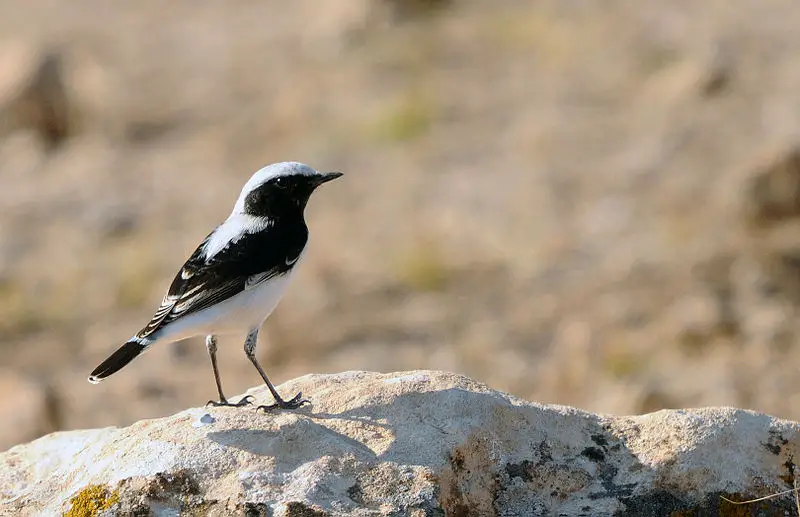
Finsch’s wheatear is a small passerine bird from the family Muscicapidae, found in semi-desert and stony hillside areas of Turkey to Afghanistan and western Pakistan.
It has an average length of around 15–16 cm and feeds on insects as its primary food source.
The male Finsch’s Wheatear is generally greyish brown above with white underparts while the female usually appears more buffy or yellowish below.
During breeding season it can be seen displaying typical flycatcher behaviour; hovering before diving down onto prey.
As a migratory species, this attractive little bird travels short distances during winter months to warmer climates within their range where they often form large roosting flocks at night time near water sources such as rivers or lakesides.Scientific classification:
| Kingdom | Animalia |
| Phylum | Chordata |
| Class | Aves |
| Order | Passeriformes |
| Family | Muscicapidae |
| Genus | Oenanthe |
| Species | O. finschii |
28. Red-Throated Thrush
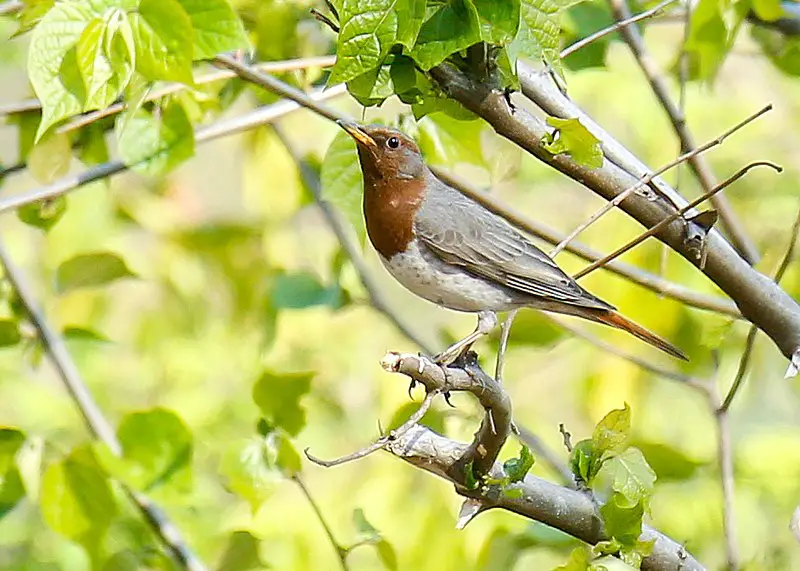
The red-throated thrush is a passerine bird of the thrush family. It has distinctive scarlet feathers on its neck and breast, hence its name.
This species can be found across Europe, Asia and North America and prefers to inhabit open woodlands or scrubby terrain with plenty of undergrowth for sheltering during breeding season.
Red-throated Thrushes are omnivorous birds that feed mainly on insects but also eat berries when available in autumn months.
They often perch high up in trees while searching for food before quickly swooping down onto their prey below them.
Their melodic songs consist of a variety of flute-like whistles which make them especially popular among nature enthusiasts everywhere.Scientific classification:
| Kingdom | Animalia |
| Phylum | Chordata |
| Class | Aves |
| Order | Passeriformes |
| Family | Turdidae |
| Genus | Turdus |
| Species | T. ruficollis |
29. White-Winged Grosbeak
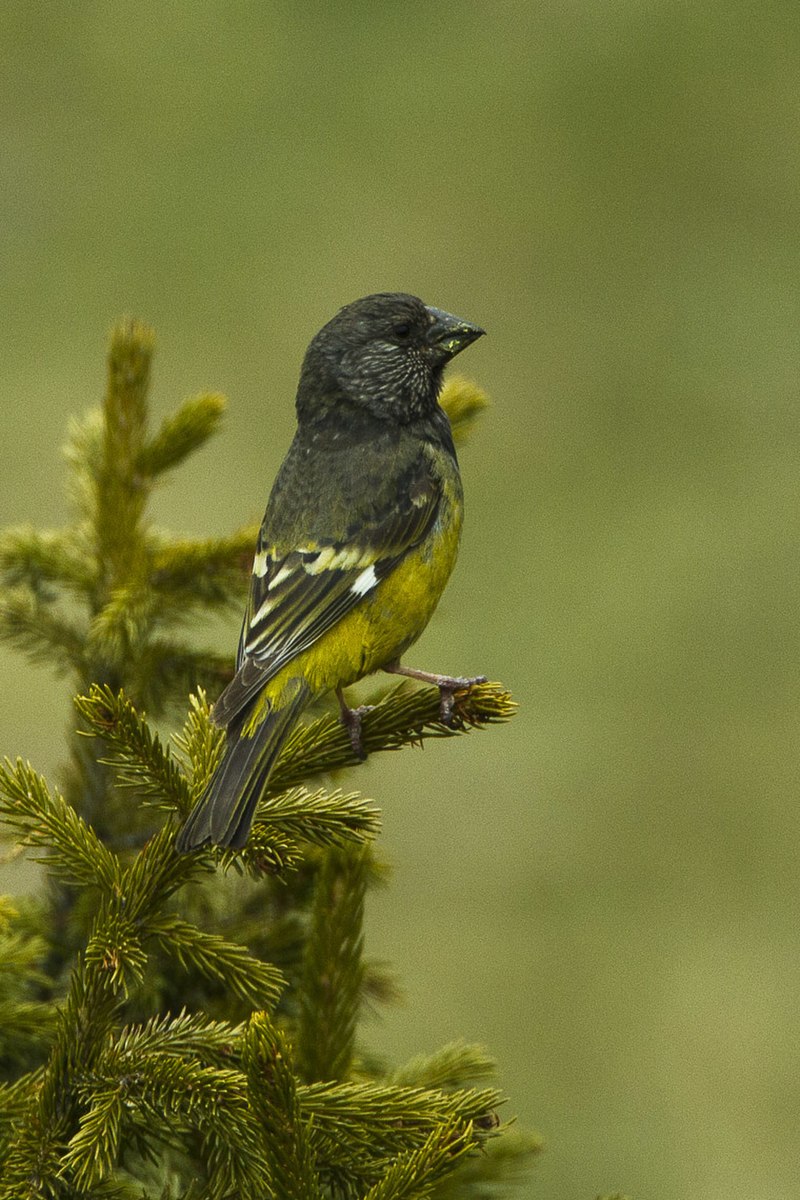
The white-winged grosbeak is a species of finch found in many countries across Asia. It prefers boreal forests, or coniferous trees such as cedar and pine, for its natural habitat.
This bird belongs to the Fringillidae family alongside another genus known as Eophona which forms part of the same phylogenetic group.
The body length of this species can range from 14–15 cm with males having more colourful feathers than females; they also possess an eye stripe that varies between yellow and orange colours on their head along with a black patch on each side at the base of their tail.
These birds are omnivores eating both plant material like fruits and insects too. They may be seen in pairs or small groups but usually sing solo due to territoriality.Scientific classification:
| Kingdom | Animalia |
| Phylum | Chordata |
| Class | Aves |
| Order | Passeriformes |
| Family | Fringillidae |
| Subfamily | Carduelinae |
| Genus | Mycerobas |
| Species | M. carnipes |